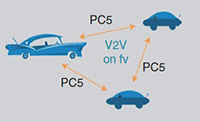|
 The proposed rule issued in December 2016 by the US Department of
Transportation (DOT) requires automakers to include vehicle-to-vehicle
(V2V) technologies in all new light-duty vehicles. The rule suggests
developing standardized messaging technology together with industry that
would advance the deployment of connected vehicle technologies throughout
the United States.
The proposed rule issued in December 2016 by the US Department of
Transportation (DOT) requires automakers to include vehicle-to-vehicle
(V2V) technologies in all new light-duty vehicles. The rule suggests
developing standardized messaging technology together with industry that
would advance the deployment of connected vehicle technologies throughout
the United States.
The notice of proposed rulemaking would mandate V2V
communication technology on all new light-duty vehicles, enabling a
multitude of new crashavoidance applications that, once fully deployed,
could prevent hundreds of thousands of crashes every year by helping
vehicles communicate with each other. The notice will be open for public
comment for 90 days.
Separately, the DOT’s Federal Highway
Administration plans to issue guidance for vehicle-to-infrastructure (V2I)
communications, which will help transportation planners integrate the
technologies, allowing vehicles to communicate with roadway infrastructure
such as traffic lights, stop signs, and work zones to improve mobility,
reduce congestion, and increase safety.
The V2V devices would use dedicated short-range
communications (DSRC), the U.S. version of IEEE 802.11p, to transmit
data, such as location, direction, and speed, to nearby vehicles. That
data would be updated and broadcast up to ten times per second to nearby
vehicles. Using that information, V2V-equipped vehicles can identify risks
and provide warnings to drivers to avoid imminent crashes.
Vehicles that contain automated driving functions,
such as automatic emergency braking and adaptive cruise control, could
also benefit from the use of V2V data to help avoid or reduce the
consequences of crashes. Privacy is also protected in V2V safety
transmissions, as V2V technology does not involve the exchange of
information linked to an individual, and the proposed rule requires
extensive privacy and security controls in all V2V devices.
ITS America believes that intelligent transportation is
the next technological revolution, as tech booms are defined by powerful
clusters of new and dynamic technologies that drive productivity. ITS
America sees promising technology and service clusters forming around
three categories:
- Vehicles (connected and/or automated vehicles and delivery drones)
- Infrastructure (through the Internet-of-Things)
- Transportation users (through mobility as a service and when-I-want-it/where-I-want-it logistics).
With that in mind, the road map includes the following parts:
- Accelerate the deployment of intelligent transportation
- Remove roadblocks for the deployment of intelligent transportation
- Support new and long-term funding and financing for technology-driven mobility and intelligent transportation infrastructure deployment
- Reinvest in communities through smart technology.
Full article: IEEE Vehicular Technology Magazine, Volume 12, Number 2, June 2017 |